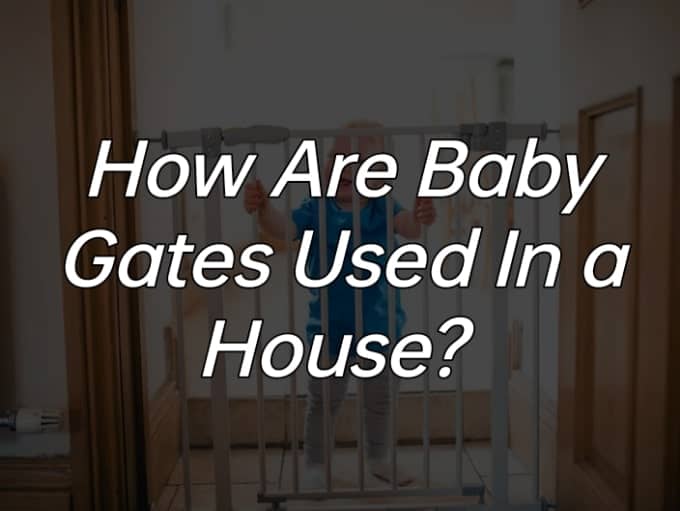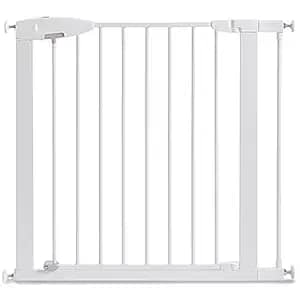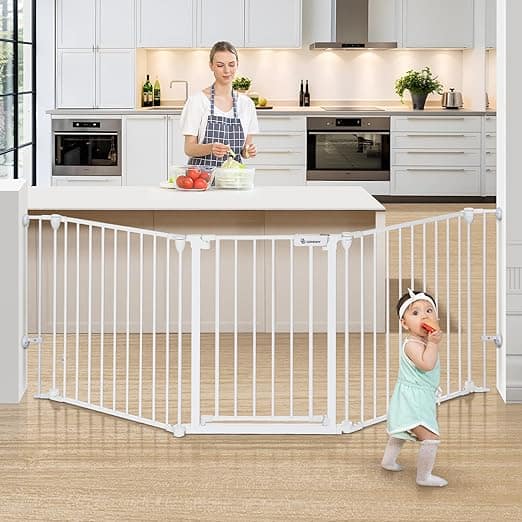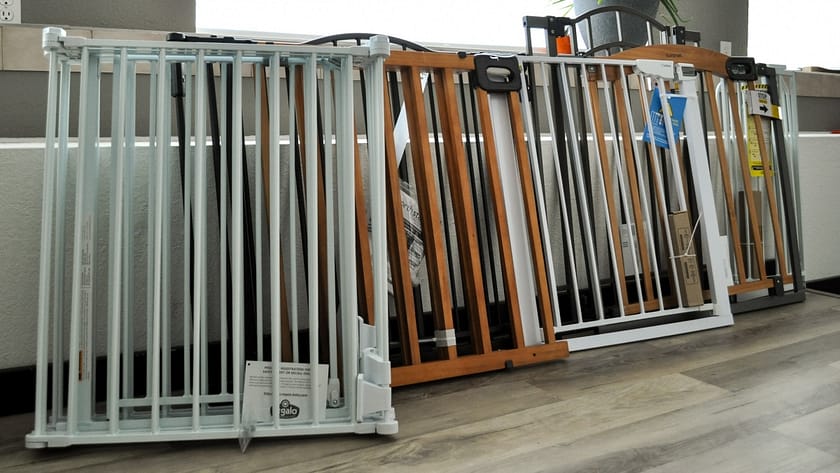Table of Contents
ToggleHave you ever wondered, “How are baby gates used in a house?” Well, baby gates play an essential role in providing a safe environment for our little explorers. As babies learn to crawl and walk, their curiosity leads them to every corner of the house.
Baby gates act as barriers, preventing them from accessing stairs, kitchens, and other potential hazard areas, giving parents peace of mind knowing their little ones are exploring safely.
How are baby gates used in a house?
Baby gates are incredibly versatile and can be used in several ways within a household:
- Doorway Blockers: Baby gates can be installed in doorways to keep infants away from rooms filled with potential hazards, such as the kitchen or bathroom.
- Stair Protectors: One of the most common uses for baby gates is at the top or bottom of stairs to prevent babies from falling them.
- Room Dividers: Some baby gates are long enough to act as room dividers, allowing parents to confine their children to a safe play area.
- Fireplace Guards: Baby gates can also be used to block off fireplaces, heaters, or other potential hot surfaces that could harm a child.
- Outdoor Usage: Outside, baby gates can be used to create a safe play area, keeping the child away from pools, grills, or other potential outdoor hazards.
By understanding these uses, parents can make informed decisions on how to best implement baby gates in their homes to ensure child safety.
Introducing baby gates in the home
Introducing baby gates into a home setting is an important step in childproofing.
It’s not just about confining the child but creating a safe exploration space for them. Parents or caregivers should take into account the specific configuration and features of their home when deciding where to install these gates.
Factors such as the presence of stairs, the location of potentially hazardous rooms like the kitchen, and the amount of open space can all influence the positioning and number of gates needed.
Furthermore, it’s essential to remember that baby gates are not a substitute for supervision, but rather a tool to assist in creating a safer environment for children.
Why they are essential for safety?
Baby gates are essential for safety as they serve as the first line of defense against potential dangers in the home environment.
They prevent babies from entering areas of the house that contain potentially harmful elements.
For instance, the kitchen contains sharp objects, hot surfaces, and hazardous chemicals that could easily harm a curious child.
Similarly, bathrooms often contain cleaning supplies and medications that pose a threat to children.
Furthermore, stairs present a significant risk for children who are just learning to move around.
A tumble down a flight of stairs can lead to serious injuries. By placing a baby gate at the top and bottom of stairs, parents can effectively prevent such accidents.
In addition to indoor hazards, baby gates also prove useful for outdoor areas.
Pools, grills, gardening equipment, and other potential hazards can be effectively cordoned off with a baby gate, allowing children to enjoy the outdoors safely.
However, while baby gates are vital, they are not foolproof, and active supervision is still necessary.
Parents should always be aware of their child’s activities and whereabouts, even with safety measures like baby gates in place.
Types of baby gates and what makes them different:
There are a variety of baby gates available on the market, each with its unique features, strengths, and limitations. Understanding these differences is crucial in choosing the right baby gate for your home and your child’s needs:
- Pressure-Mounted Gates: These gates are held in place by pressure against the door frame or the wall. They’re easy to install and move but are not recommended for stairs as they can be accidentally knocked down.
- Hardware-Mounted Gates: These gates are secured with screws to the walls or door frames. They provide a higher level of security and are ideal for protecting stairs, but they leave permanent holes when removed.
- Retractable Gates: These gates can be pulled across to block an area and easily retracted when not needed. They’re flexible and convenient, but they might not be as robust as other types.
- Freestanding Gates: These stand-alone units are perfect for open floor plans. They can be easily moved and adjusted to fit different spaces, but they may not be stable if pushed or leaned on heavily.
- Travel Gates: These lightweight, portable gates are ideal for vacations or visits to grandparents. They’re easy to pack along but may not be as sturdy as permanent options.
For a more detailed review of each type of baby gate, visit this comprehensive guide. Remember, safety should always be paramount when choosing a baby gate. Consider your home’s layout, your child’s age and mobility, and the gate’s specific features before making a decision.
Identifying the right-sized gate for your home and baby:
Identifying the right-sized gate for your home and baby is crucial for effective and safe use. Sizes of baby gates vary, and it’s important to choose one that fits well within the desired space:
- Standard Gates: Most standard baby gates are designed to fit doorways between 30 and 45 inches wide. They are perfect for blocking standard door passages and small entryways.
- Wide Gates: If you need to secure a wider space, there are gates designed to fit openings up to 60 inches wide. These are ideal for open floor plans or wide hallways.
- Extra-Wide Gates: For really large spaces, some gates can extend up to 144 inches wide. These are typically configurable, allowing you to adapt the gate to your specific needs.
- Height: In terms of height, a standard baby gate is usually about 30 inches tall. It’s important to remember that as your child grows, they might be able to climb over shorter gates. Therefore, if you have an adventurous toddler, you might want to consider a taller gate.
Remember, the right fit is essential for the effectiveness and safety of the gate. Always measure the opening where you plan to install the gate before making a purchase.
Installing a baby gate step-by-step guide:
Installing a baby gate can seem daunting, but with the right instructions and equipment, it can be a straightforward task. Here’s a high-level overview of the steps involved:
- Choose the Right Location: Select the area in your home where you want to install the baby gate. The location will depend on where potential hazards are and where your child spends most of their time.
- Measure the Space: Accurately measure the width of the opening where you’ll install the gate. Ensure that the gate you’ve chosen fits the space appropriately.
- Check the Wall Type: Different wall materials require different hardware, so be sure to check whether your walls are drywall, plaster, or brick before installation.
- Install the Gate: Depending on the type of gate you have, this process might involve screwing hardware into the wall, or it might involve pressure-mounting the gate into the doorway or hallway.
- Check for Stability: After installation, check the stability of the gate by applying pressure. If it remains firm, it’s ready for use. If not, adjust as necessary.
For a more detailed step-by-step guide, visit this comprehensive resource on how to install baby gates safely. Remember, when installing a baby gate, safety should always be the primary concern.
Conclusion:
In conclusion, baby gates are an essential tool for ensuring the safety of young children in the home. They help to mitigate potential hazards, both indoors and outdoors, by restricting access to certain areas.
Various types of baby gates, such as pressure-mounted, hardware-mounted, retractable, freestanding, and travel gates, offer different features and levels of security, making it important to understand and choose the right one based on your home’s layout and your child’s needs.
Furthermore, the size of the gate matters in terms of effectiveness and safety. Therefore, identifying the right-sized gate and installing it securely is vital. Despite the protection offered by baby gates, they are not a substitute for active supervision.
Parents must always remain vigilant about their child’s activities and whereabouts to ensure their ultimate safety.






2 thoughts on “How Are Baby Gates Used in a house?”